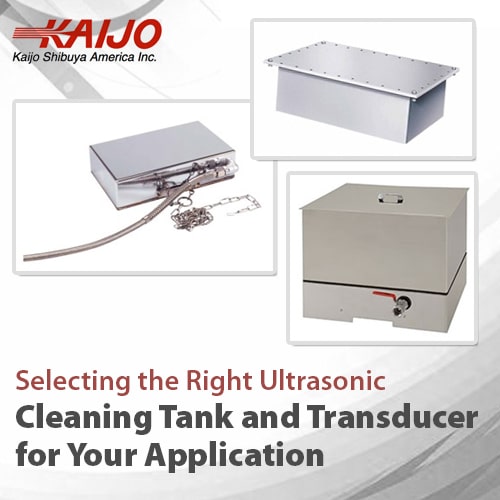Selecting the Right Ultrasonic Tank and Transducer for Your Application
October 10, 2019
 Ultrasonic cleaning systems are made up of an ultrasonic generator to produce the electric ultrasonic frequency, a transducer to convert the electric signal to sound waves and a tank to hold the cleaning solution. The choice of the transducer and cleaning tank influences how the ultrasonic cleaning system can be used and what parts can be cleaned. Selecting the appropriate transducer and the right tank helps ensure that the ultrasonic cleaning system performs as expected and satisfies the requirements of your cleaning application.
Ultrasonic cleaning systems are made up of an ultrasonic generator to produce the electric ultrasonic frequency, a transducer to convert the electric signal to sound waves and a tank to hold the cleaning solution. The choice of the transducer and cleaning tank influences how the ultrasonic cleaning system can be used and what parts can be cleaned. Selecting the appropriate transducer and the right tank helps ensure that the ultrasonic cleaning system performs as expected and satisfies the requirements of your cleaning application.
How to Select the Right Tank
Several characteristics to consider when selecting ultrasonic cleaning tanks include the following:
- Size – the tank has to be big enough to hold the parts to be cleaned.
- Basket – a basket to hold small parts is recommended.
- Heating – some cleaning applications benefit from a tank that can heat the cleaning solution.
- Thickness of the tank material to enhance the sound distribution and prevent cracking.
Selecting the right size of tank is critical for meeting the needs of your cleaning application while avoiding an over-sized tank whose operation is inefficient. If your cleaning operation always cleans the same parts, you can get a custom-designed tank that just fits the largest parts. If you are buying a general purpose cleaning system, a rectangular tank lets you fit longer pieces in one direction and shorter pieces the other way. It is important not to overload the tank because sound waves blocked by too many parts can produce dead spots where cleaning is uneven.
A basket is recommended for delicate parts or for a large number of small parts. Delicate parts that come in contact with the bottom or sides of the cleaning tank can start vibrating and can be damaged as a result. A basket keeps the parts suspended safely in the cleaning solution.
If the material to be removed from the parts is heavy grease or oil, it can be softened by heat. This allows the ultrasonic waves to act more quickly and helps shorten cleaning times. The ideal tank for ultrasonic cleaning with a heated solution has a heating system that heats up rapidly and is controlled to maintain a temperature below the boiling point of the cleaning solution. A typical temperature for heated ultrasonic cleaning is around 80 degrees centigrade.
The thickness of the tank material can enhance the sound distribution within the tank for some cleaning applications. In addition the thickness of the cleaning tank material needs to be considered since some frequencies can cause the material to crack when used over an extended time period.
How to Select the Right Transducer
Ultrasonic cleaning transducers are sealed metal boxes with a heavy metal plate on one side. The transducer elements make the plate vibrate at an ultrasonic frequency to produce the sound waves in the cleaning solution. The transducers arrays can be immersible, bolt-on or directly mounted. The design of the ultrasonic cleaning system can affect the type of transducer required and the type of transducer can influence how the system can be used.
Immersible transducers are the most flexible because they can be placed in any tank. The transducer is water proof and is attached to a cable. The cable is plugged into the ultrasonic generator and the transducer can be suspended in the cleaning solution to produce the ultrasonic sound waves. The immersible transducers are especially suited for cleaning systems with existing tanks or systems that require flexibility in cleaning applications.
Bolt-on and mounted transducers are fixed to the bottom or sides of the cleaning tanks. Mounted transducers often come with turnkey systems and are integrated into the ultrasonic cleaning system. Bolt-on transducers can be exchanged but they are not as flexible as immersible transducers.
How to Combine the Right Tanks with the Right Transducers
While selecting suitable ultrasonic cleaning tanks and the right type of transducer is not difficult, combining the two to ensure top performance of the ultrasonic cleaning system can require input from the manufacturer. This is especially true for larger tanks that may need more than one transducer in special configurations to evenly fill the tank with sound waves. Kaijo can provide expert advice for ultrasonic cleaning installations and make sure your system delivers the expected performance.
Once an appropriate cleaning system is selected, Kaijo can propose components from their extensive product line of ultrasonic cleaners to assemble a complete ultrasonic system.
Kaijo offers a free consultation on selecting the right ultrasonic cleaning system and works with customers in many different industries.





